BUSM3249: Cultural Diversity Initiatives for Employee Engagement
VerifiedAdded on 2023/06/14
|10
|2345
|311
Report
AI Summary
This report defines employee engagement as the enthusiasm and dedication employees feel towards their jobs and organizations, highlighting its positive impact on individual outcomes and company performance. It emphasizes the importance of cultural diversity in the workplace and suggests that employers who are culturally sensitive can ensure employee satisfaction and engagement. The report proposes several initiatives, including adopting a learning culture, promoting transparency and honest communication, recognizing employees' contributions, fostering effective manager-employee relationships, and providing flexibility to accommodate diverse cultural needs. It further discusses the positive effects of employee engagement on profitability, retention, workplace happiness, productivity, innovation, and communication, referencing Kumar and Pansari's five dimensions of employee engagement: satisfaction, identification, commitment, loyalty, and performance. The report concludes by noting the negative correlation between employee engagement and absenteeism, and the positive correlation with focus and motivation, ultimately leading to higher productivity and profitability.
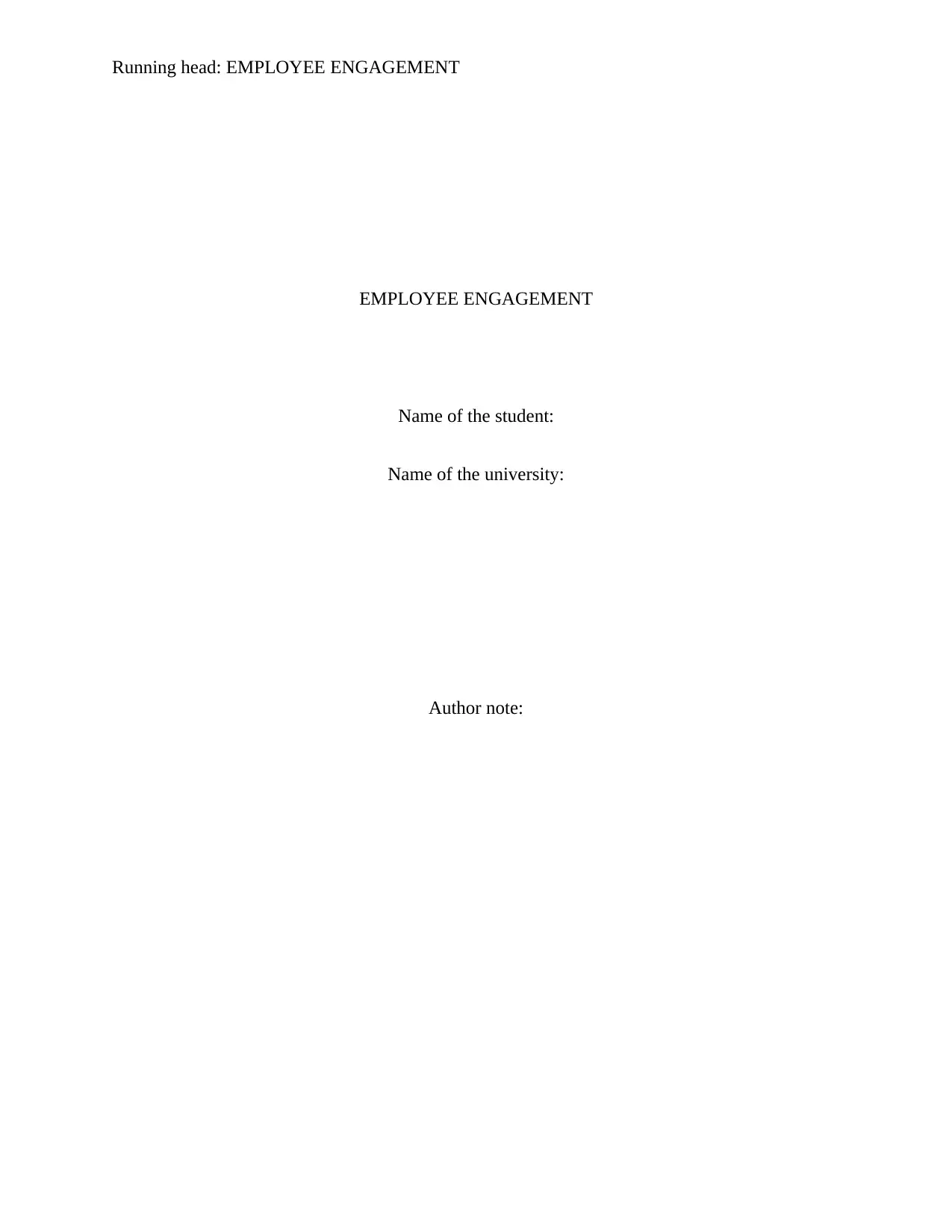
Running head: EMPLOYEE ENGAGEMENT
EMPLOYEE ENGAGEMENT
Name of the student:
Name of the university:
Author note:
EMPLOYEE ENGAGEMENT
Name of the student:
Name of the university:
Author note:
Paraphrase This Document
Need a fresh take? Get an instant paraphrase of this document with our AI Paraphraser
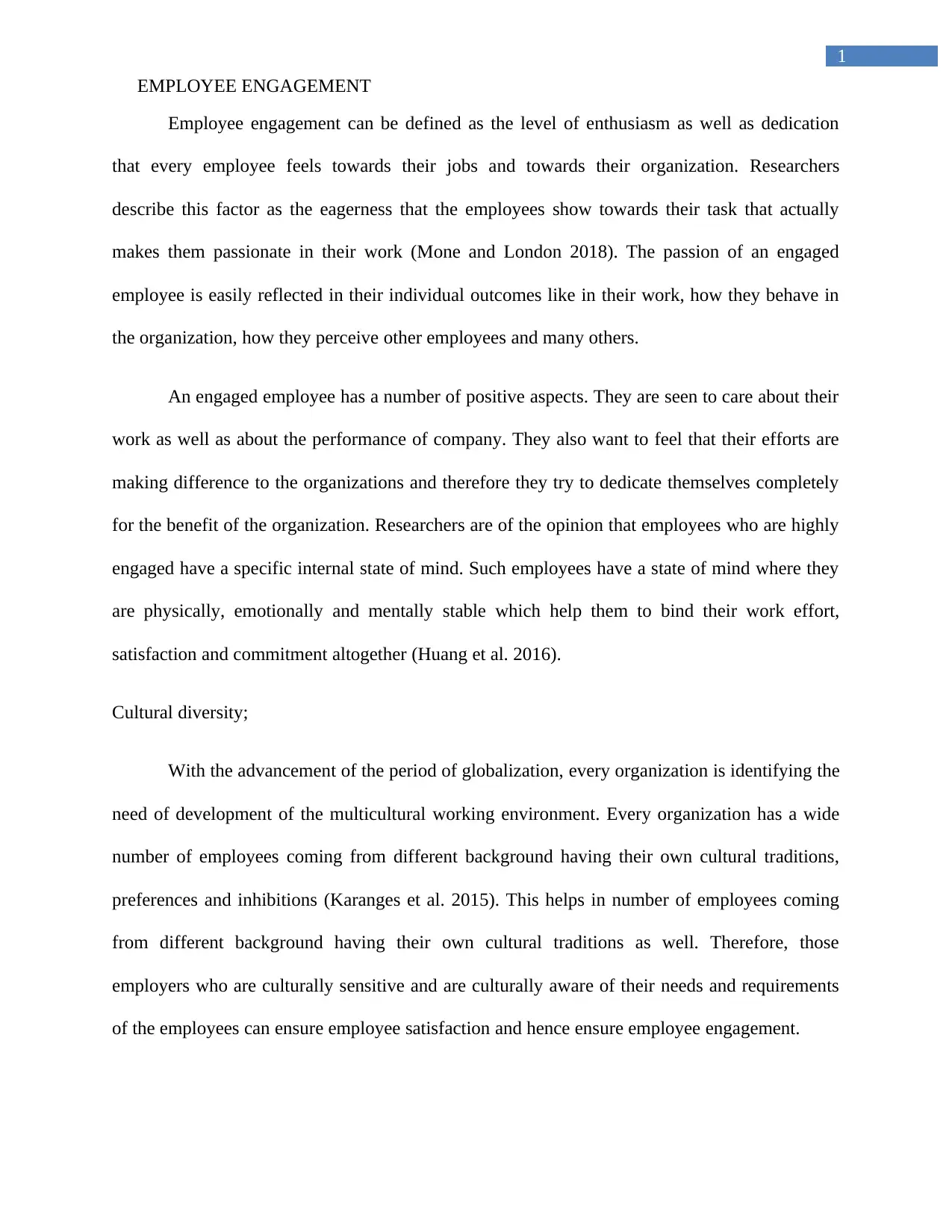
1
EMPLOYEE ENGAGEMENT
Employee engagement can be defined as the level of enthusiasm as well as dedication
that every employee feels towards their jobs and towards their organization. Researchers
describe this factor as the eagerness that the employees show towards their task that actually
makes them passionate in their work (Mone and London 2018). The passion of an engaged
employee is easily reflected in their individual outcomes like in their work, how they behave in
the organization, how they perceive other employees and many others.
An engaged employee has a number of positive aspects. They are seen to care about their
work as well as about the performance of company. They also want to feel that their efforts are
making difference to the organizations and therefore they try to dedicate themselves completely
for the benefit of the organization. Researchers are of the opinion that employees who are highly
engaged have a specific internal state of mind. Such employees have a state of mind where they
are physically, emotionally and mentally stable which help them to bind their work effort,
satisfaction and commitment altogether (Huang et al. 2016).
Cultural diversity;
With the advancement of the period of globalization, every organization is identifying the
need of development of the multicultural working environment. Every organization has a wide
number of employees coming from different background having their own cultural traditions,
preferences and inhibitions (Karanges et al. 2015). This helps in number of employees coming
from different background having their own cultural traditions as well. Therefore, those
employers who are culturally sensitive and are culturally aware of their needs and requirements
of the employees can ensure employee satisfaction and hence ensure employee engagement.
EMPLOYEE ENGAGEMENT
Employee engagement can be defined as the level of enthusiasm as well as dedication
that every employee feels towards their jobs and towards their organization. Researchers
describe this factor as the eagerness that the employees show towards their task that actually
makes them passionate in their work (Mone and London 2018). The passion of an engaged
employee is easily reflected in their individual outcomes like in their work, how they behave in
the organization, how they perceive other employees and many others.
An engaged employee has a number of positive aspects. They are seen to care about their
work as well as about the performance of company. They also want to feel that their efforts are
making difference to the organizations and therefore they try to dedicate themselves completely
for the benefit of the organization. Researchers are of the opinion that employees who are highly
engaged have a specific internal state of mind. Such employees have a state of mind where they
are physically, emotionally and mentally stable which help them to bind their work effort,
satisfaction and commitment altogether (Huang et al. 2016).
Cultural diversity;
With the advancement of the period of globalization, every organization is identifying the
need of development of the multicultural working environment. Every organization has a wide
number of employees coming from different background having their own cultural traditions,
preferences and inhibitions (Karanges et al. 2015). This helps in number of employees coming
from different background having their own cultural traditions as well. Therefore, those
employers who are culturally sensitive and are culturally aware of their needs and requirements
of the employees can ensure employee satisfaction and hence ensure employee engagement.
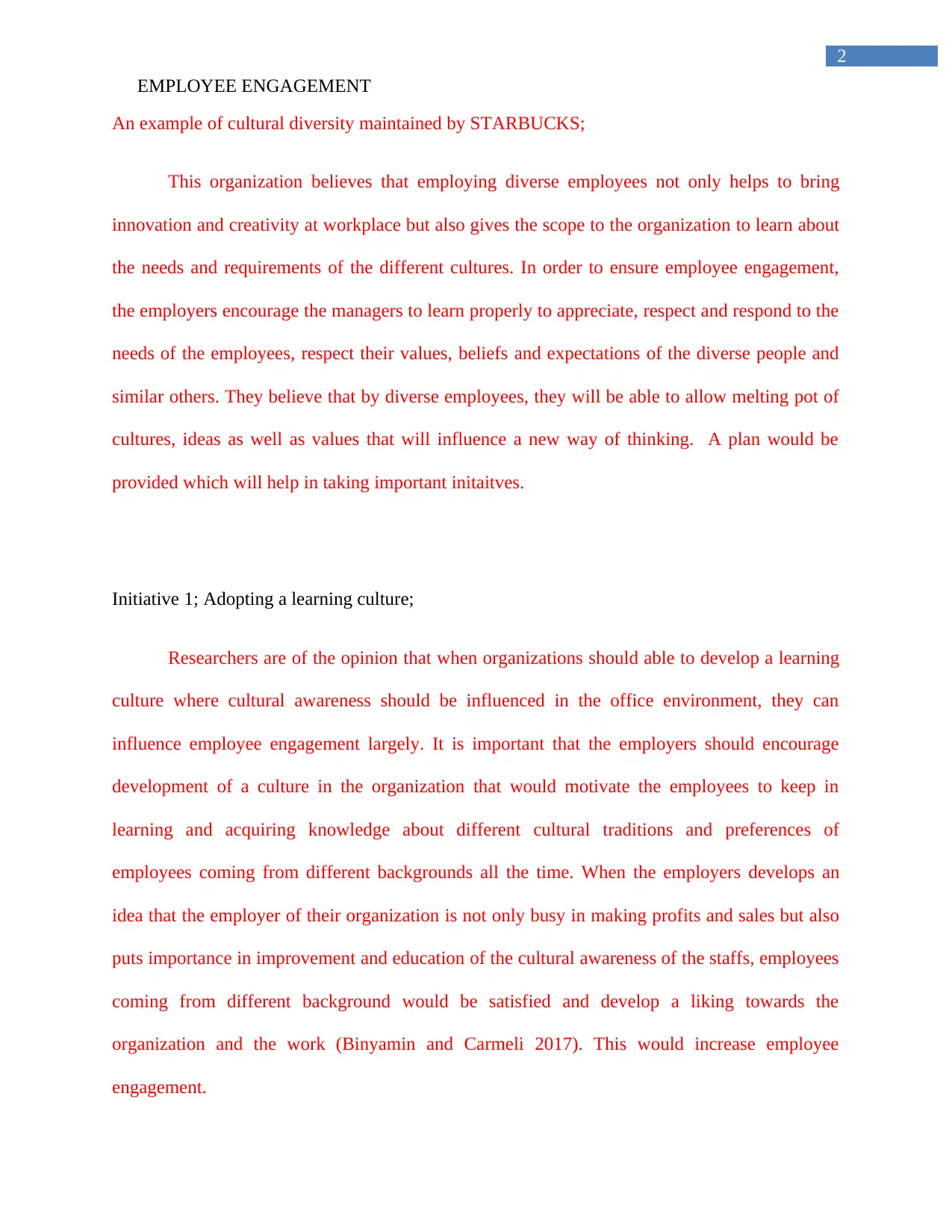
2
EMPLOYEE ENGAGEMENT
An example of cultural diversity maintained by STARBUCKS;
This organization believes that employing diverse employees not only helps to bring
innovation and creativity at workplace but also gives the scope to the organization to learn about
the needs and requirements of the different cultures. In order to ensure employee engagement,
the employers encourage the managers to learn properly to appreciate, respect and respond to the
needs of the employees, respect their values, beliefs and expectations of the diverse people and
similar others. They believe that by diverse employees, they will be able to allow melting pot of
cultures, ideas as well as values that will influence a new way of thinking. A plan would be
provided which will help in taking important initaitves.
Initiative 1; Adopting a learning culture;
Researchers are of the opinion that when organizations should able to develop a learning
culture where cultural awareness should be influenced in the office environment, they can
influence employee engagement largely. It is important that the employers should encourage
development of a culture in the organization that would motivate the employees to keep in
learning and acquiring knowledge about different cultural traditions and preferences of
employees coming from different backgrounds all the time. When the employers develops an
idea that the employer of their organization is not only busy in making profits and sales but also
puts importance in improvement and education of the cultural awareness of the staffs, employees
coming from different background would be satisfied and develop a liking towards the
organization and the work (Binyamin and Carmeli 2017). This would increase employee
engagement.
EMPLOYEE ENGAGEMENT
An example of cultural diversity maintained by STARBUCKS;
This organization believes that employing diverse employees not only helps to bring
innovation and creativity at workplace but also gives the scope to the organization to learn about
the needs and requirements of the different cultures. In order to ensure employee engagement,
the employers encourage the managers to learn properly to appreciate, respect and respond to the
needs of the employees, respect their values, beliefs and expectations of the diverse people and
similar others. They believe that by diverse employees, they will be able to allow melting pot of
cultures, ideas as well as values that will influence a new way of thinking. A plan would be
provided which will help in taking important initaitves.
Initiative 1; Adopting a learning culture;
Researchers are of the opinion that when organizations should able to develop a learning
culture where cultural awareness should be influenced in the office environment, they can
influence employee engagement largely. It is important that the employers should encourage
development of a culture in the organization that would motivate the employees to keep in
learning and acquiring knowledge about different cultural traditions and preferences of
employees coming from different backgrounds all the time. When the employers develops an
idea that the employer of their organization is not only busy in making profits and sales but also
puts importance in improvement and education of the cultural awareness of the staffs, employees
coming from different background would be satisfied and develop a liking towards the
organization and the work (Binyamin and Carmeli 2017). This would increase employee
engagement.
⊘ This is a preview!⊘
Do you want full access?
Subscribe today to unlock all pages.

Trusted by 1+ million students worldwide
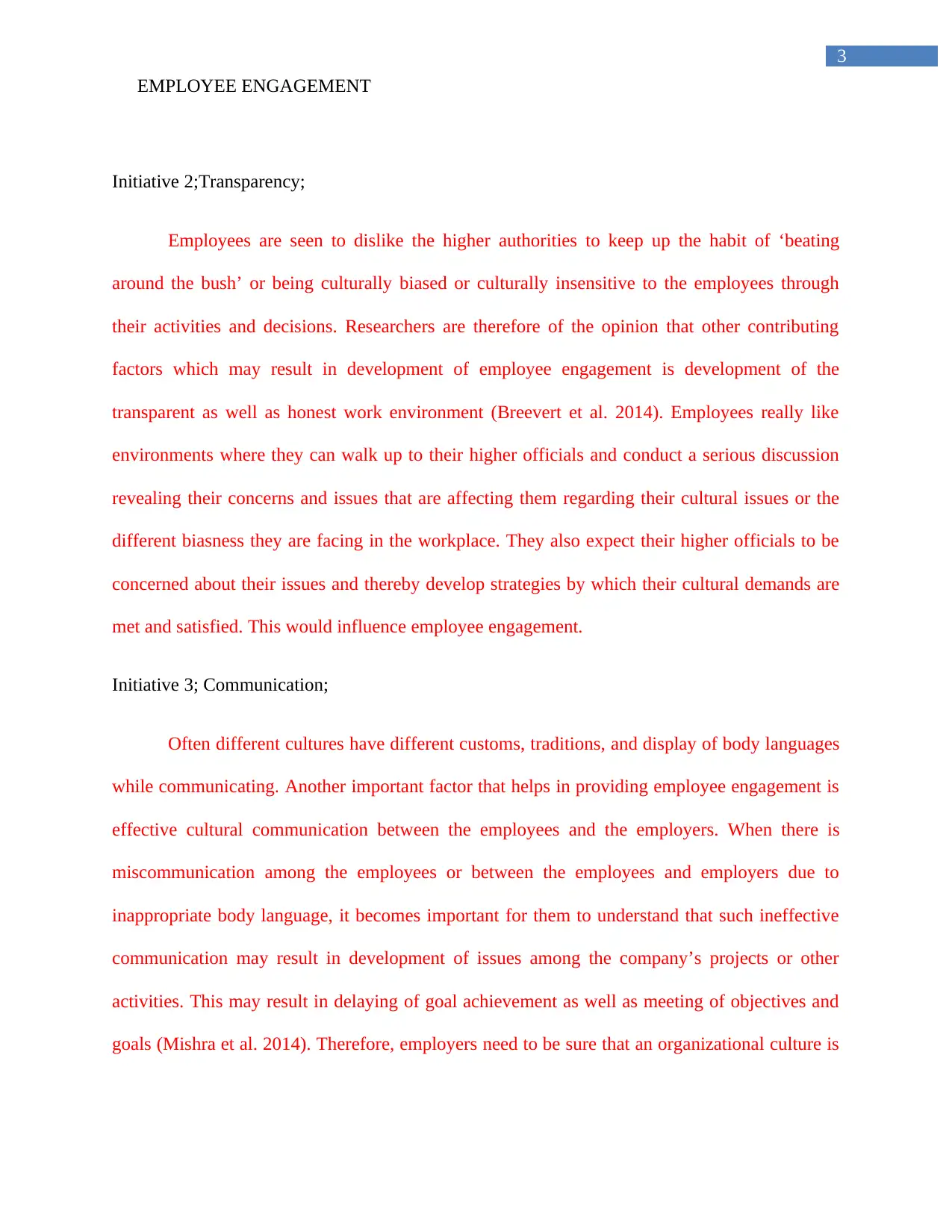
3
EMPLOYEE ENGAGEMENT
Initiative 2;Transparency;
Employees are seen to dislike the higher authorities to keep up the habit of ‘beating
around the bush’ or being culturally biased or culturally insensitive to the employees through
their activities and decisions. Researchers are therefore of the opinion that other contributing
factors which may result in development of employee engagement is development of the
transparent as well as honest work environment (Breevert et al. 2014). Employees really like
environments where they can walk up to their higher officials and conduct a serious discussion
revealing their concerns and issues that are affecting them regarding their cultural issues or the
different biasness they are facing in the workplace. They also expect their higher officials to be
concerned about their issues and thereby develop strategies by which their cultural demands are
met and satisfied. This would influence employee engagement.
Initiative 3; Communication;
Often different cultures have different customs, traditions, and display of body languages
while communicating. Another important factor that helps in providing employee engagement is
effective cultural communication between the employees and the employers. When there is
miscommunication among the employees or between the employees and employers due to
inappropriate body language, it becomes important for them to understand that such ineffective
communication may result in development of issues among the company’s projects or other
activities. This may result in delaying of goal achievement as well as meeting of objectives and
goals (Mishra et al. 2014). Therefore, employers need to be sure that an organizational culture is
EMPLOYEE ENGAGEMENT
Initiative 2;Transparency;
Employees are seen to dislike the higher authorities to keep up the habit of ‘beating
around the bush’ or being culturally biased or culturally insensitive to the employees through
their activities and decisions. Researchers are therefore of the opinion that other contributing
factors which may result in development of employee engagement is development of the
transparent as well as honest work environment (Breevert et al. 2014). Employees really like
environments where they can walk up to their higher officials and conduct a serious discussion
revealing their concerns and issues that are affecting them regarding their cultural issues or the
different biasness they are facing in the workplace. They also expect their higher officials to be
concerned about their issues and thereby develop strategies by which their cultural demands are
met and satisfied. This would influence employee engagement.
Initiative 3; Communication;
Often different cultures have different customs, traditions, and display of body languages
while communicating. Another important factor that helps in providing employee engagement is
effective cultural communication between the employees and the employers. When there is
miscommunication among the employees or between the employees and employers due to
inappropriate body language, it becomes important for them to understand that such ineffective
communication may result in development of issues among the company’s projects or other
activities. This may result in delaying of goal achievement as well as meeting of objectives and
goals (Mishra et al. 2014). Therefore, employers need to be sure that an organizational culture is
Paraphrase This Document
Need a fresh take? Get an instant paraphrase of this document with our AI Paraphraser
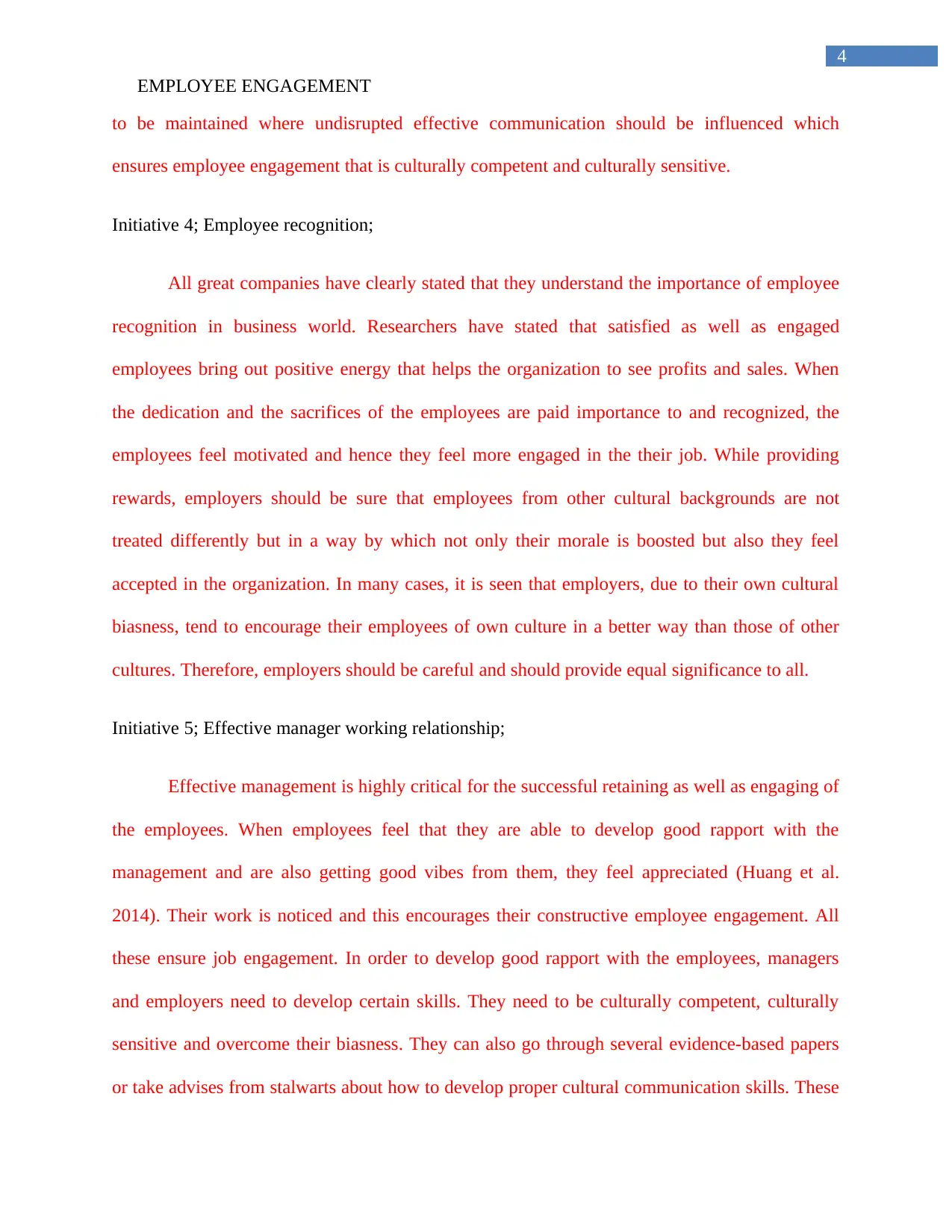
4
EMPLOYEE ENGAGEMENT
to be maintained where undisrupted effective communication should be influenced which
ensures employee engagement that is culturally competent and culturally sensitive.
Initiative 4; Employee recognition;
All great companies have clearly stated that they understand the importance of employee
recognition in business world. Researchers have stated that satisfied as well as engaged
employees bring out positive energy that helps the organization to see profits and sales. When
the dedication and the sacrifices of the employees are paid importance to and recognized, the
employees feel motivated and hence they feel more engaged in the their job. While providing
rewards, employers should be sure that employees from other cultural backgrounds are not
treated differently but in a way by which not only their morale is boosted but also they feel
accepted in the organization. In many cases, it is seen that employers, due to their own cultural
biasness, tend to encourage their employees of own culture in a better way than those of other
cultures. Therefore, employers should be careful and should provide equal significance to all.
Initiative 5; Effective manager working relationship;
Effective management is highly critical for the successful retaining as well as engaging of
the employees. When employees feel that they are able to develop good rapport with the
management and are also getting good vibes from them, they feel appreciated (Huang et al.
2014). Their work is noticed and this encourages their constructive employee engagement. All
these ensure job engagement. In order to develop good rapport with the employees, managers
and employers need to develop certain skills. They need to be culturally competent, culturally
sensitive and overcome their biasness. They can also go through several evidence-based papers
or take advises from stalwarts about how to develop proper cultural communication skills. These
EMPLOYEE ENGAGEMENT
to be maintained where undisrupted effective communication should be influenced which
ensures employee engagement that is culturally competent and culturally sensitive.
Initiative 4; Employee recognition;
All great companies have clearly stated that they understand the importance of employee
recognition in business world. Researchers have stated that satisfied as well as engaged
employees bring out positive energy that helps the organization to see profits and sales. When
the dedication and the sacrifices of the employees are paid importance to and recognized, the
employees feel motivated and hence they feel more engaged in the their job. While providing
rewards, employers should be sure that employees from other cultural backgrounds are not
treated differently but in a way by which not only their morale is boosted but also they feel
accepted in the organization. In many cases, it is seen that employers, due to their own cultural
biasness, tend to encourage their employees of own culture in a better way than those of other
cultures. Therefore, employers should be careful and should provide equal significance to all.
Initiative 5; Effective manager working relationship;
Effective management is highly critical for the successful retaining as well as engaging of
the employees. When employees feel that they are able to develop good rapport with the
management and are also getting good vibes from them, they feel appreciated (Huang et al.
2014). Their work is noticed and this encourages their constructive employee engagement. All
these ensure job engagement. In order to develop good rapport with the employees, managers
and employers need to develop certain skills. They need to be culturally competent, culturally
sensitive and overcome their biasness. They can also go through several evidence-based papers
or take advises from stalwarts about how to develop proper cultural communication skills. These
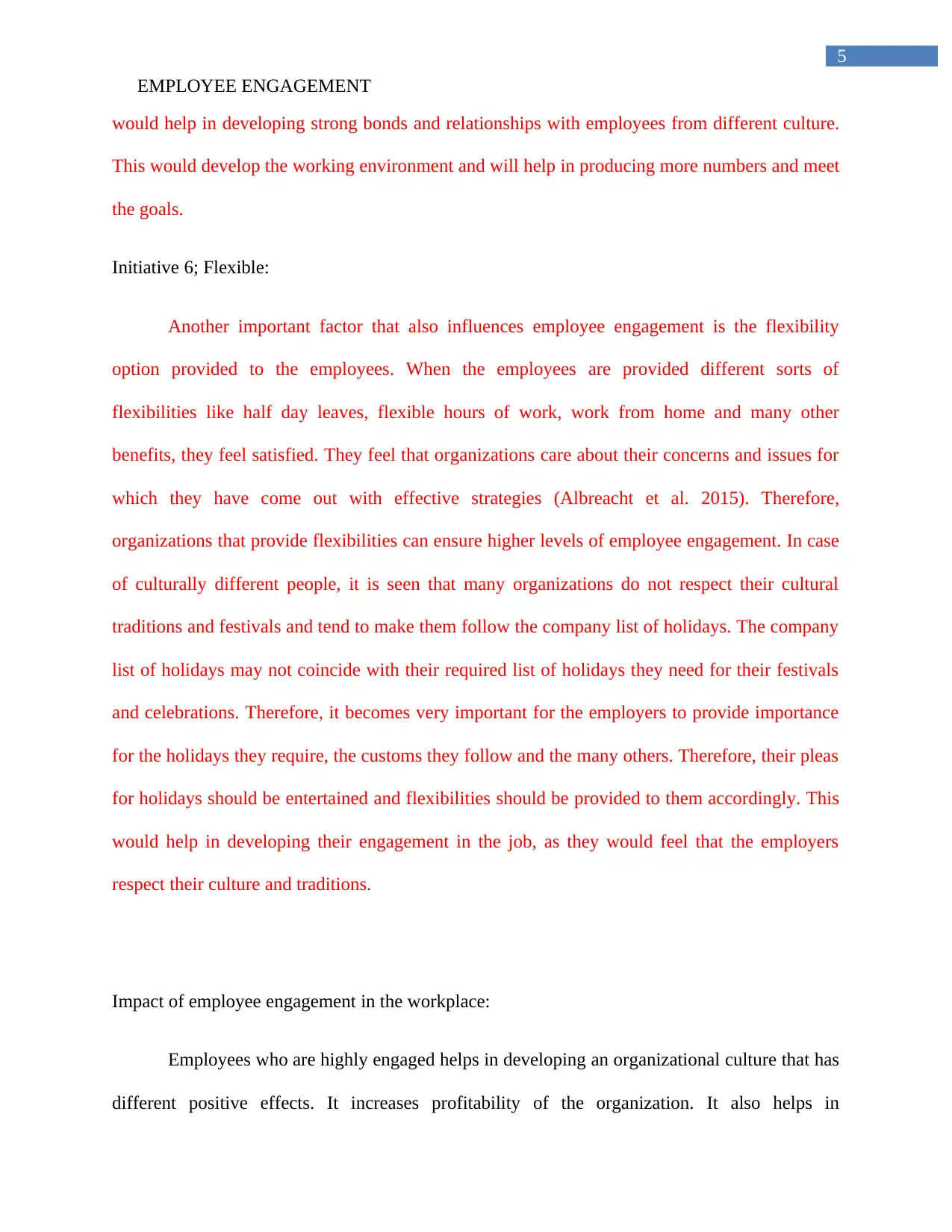
5
EMPLOYEE ENGAGEMENT
would help in developing strong bonds and relationships with employees from different culture.
This would develop the working environment and will help in producing more numbers and meet
the goals.
Initiative 6; Flexible:
Another important factor that also influences employee engagement is the flexibility
option provided to the employees. When the employees are provided different sorts of
flexibilities like half day leaves, flexible hours of work, work from home and many other
benefits, they feel satisfied. They feel that organizations care about their concerns and issues for
which they have come out with effective strategies (Albreacht et al. 2015). Therefore,
organizations that provide flexibilities can ensure higher levels of employee engagement. In case
of culturally different people, it is seen that many organizations do not respect their cultural
traditions and festivals and tend to make them follow the company list of holidays. The company
list of holidays may not coincide with their required list of holidays they need for their festivals
and celebrations. Therefore, it becomes very important for the employers to provide importance
for the holidays they require, the customs they follow and the many others. Therefore, their pleas
for holidays should be entertained and flexibilities should be provided to them accordingly. This
would help in developing their engagement in the job, as they would feel that the employers
respect their culture and traditions.
Impact of employee engagement in the workplace:
Employees who are highly engaged helps in developing an organizational culture that has
different positive effects. It increases profitability of the organization. It also helps in
EMPLOYEE ENGAGEMENT
would help in developing strong bonds and relationships with employees from different culture.
This would develop the working environment and will help in producing more numbers and meet
the goals.
Initiative 6; Flexible:
Another important factor that also influences employee engagement is the flexibility
option provided to the employees. When the employees are provided different sorts of
flexibilities like half day leaves, flexible hours of work, work from home and many other
benefits, they feel satisfied. They feel that organizations care about their concerns and issues for
which they have come out with effective strategies (Albreacht et al. 2015). Therefore,
organizations that provide flexibilities can ensure higher levels of employee engagement. In case
of culturally different people, it is seen that many organizations do not respect their cultural
traditions and festivals and tend to make them follow the company list of holidays. The company
list of holidays may not coincide with their required list of holidays they need for their festivals
and celebrations. Therefore, it becomes very important for the employers to provide importance
for the holidays they require, the customs they follow and the many others. Therefore, their pleas
for holidays should be entertained and flexibilities should be provided to them accordingly. This
would help in developing their engagement in the job, as they would feel that the employers
respect their culture and traditions.
Impact of employee engagement in the workplace:
Employees who are highly engaged helps in developing an organizational culture that has
different positive effects. It increases profitability of the organization. It also helps in
⊘ This is a preview!⊘
Do you want full access?
Subscribe today to unlock all pages.

Trusted by 1+ million students worldwide
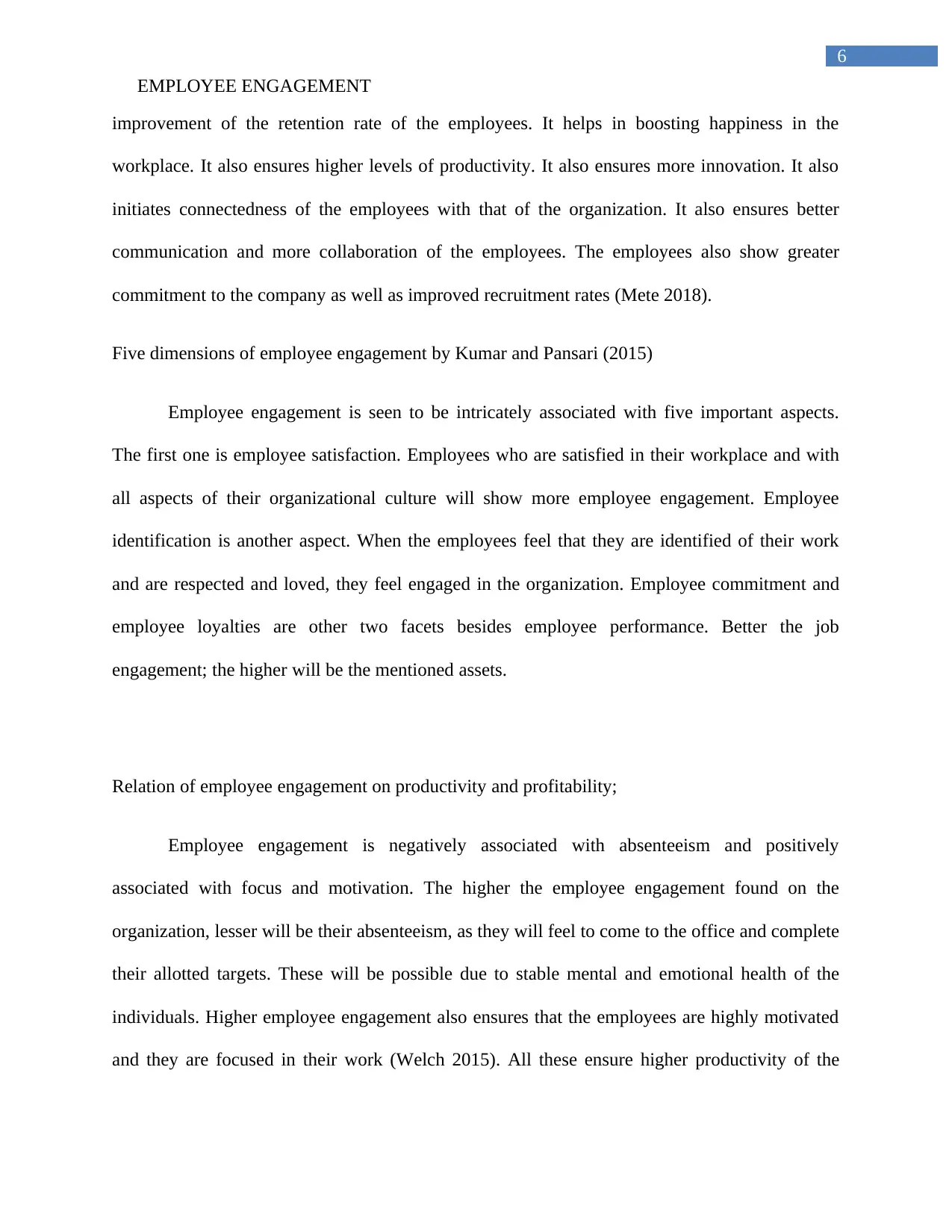
6
EMPLOYEE ENGAGEMENT
improvement of the retention rate of the employees. It helps in boosting happiness in the
workplace. It also ensures higher levels of productivity. It also ensures more innovation. It also
initiates connectedness of the employees with that of the organization. It also ensures better
communication and more collaboration of the employees. The employees also show greater
commitment to the company as well as improved recruitment rates (Mete 2018).
Five dimensions of employee engagement by Kumar and Pansari (2015)
Employee engagement is seen to be intricately associated with five important aspects.
The first one is employee satisfaction. Employees who are satisfied in their workplace and with
all aspects of their organizational culture will show more employee engagement. Employee
identification is another aspect. When the employees feel that they are identified of their work
and are respected and loved, they feel engaged in the organization. Employee commitment and
employee loyalties are other two facets besides employee performance. Better the job
engagement; the higher will be the mentioned assets.
Relation of employee engagement on productivity and profitability;
Employee engagement is negatively associated with absenteeism and positively
associated with focus and motivation. The higher the employee engagement found on the
organization, lesser will be their absenteeism, as they will feel to come to the office and complete
their allotted targets. These will be possible due to stable mental and emotional health of the
individuals. Higher employee engagement also ensures that the employees are highly motivated
and they are focused in their work (Welch 2015). All these ensure higher productivity of the
EMPLOYEE ENGAGEMENT
improvement of the retention rate of the employees. It helps in boosting happiness in the
workplace. It also ensures higher levels of productivity. It also ensures more innovation. It also
initiates connectedness of the employees with that of the organization. It also ensures better
communication and more collaboration of the employees. The employees also show greater
commitment to the company as well as improved recruitment rates (Mete 2018).
Five dimensions of employee engagement by Kumar and Pansari (2015)
Employee engagement is seen to be intricately associated with five important aspects.
The first one is employee satisfaction. Employees who are satisfied in their workplace and with
all aspects of their organizational culture will show more employee engagement. Employee
identification is another aspect. When the employees feel that they are identified of their work
and are respected and loved, they feel engaged in the organization. Employee commitment and
employee loyalties are other two facets besides employee performance. Better the job
engagement; the higher will be the mentioned assets.
Relation of employee engagement on productivity and profitability;
Employee engagement is negatively associated with absenteeism and positively
associated with focus and motivation. The higher the employee engagement found on the
organization, lesser will be their absenteeism, as they will feel to come to the office and complete
their allotted targets. These will be possible due to stable mental and emotional health of the
individuals. Higher employee engagement also ensures that the employees are highly motivated
and they are focused in their work (Welch 2015). All these ensure higher productivity of the
Paraphrase This Document
Need a fresh take? Get an instant paraphrase of this document with our AI Paraphraser

7
EMPLOYEE ENGAGEMENT
organization as lower absenteeism and higher motivation help to meet production of the
organization.
EMPLOYEE ENGAGEMENT
organization as lower absenteeism and higher motivation help to meet production of the
organization.
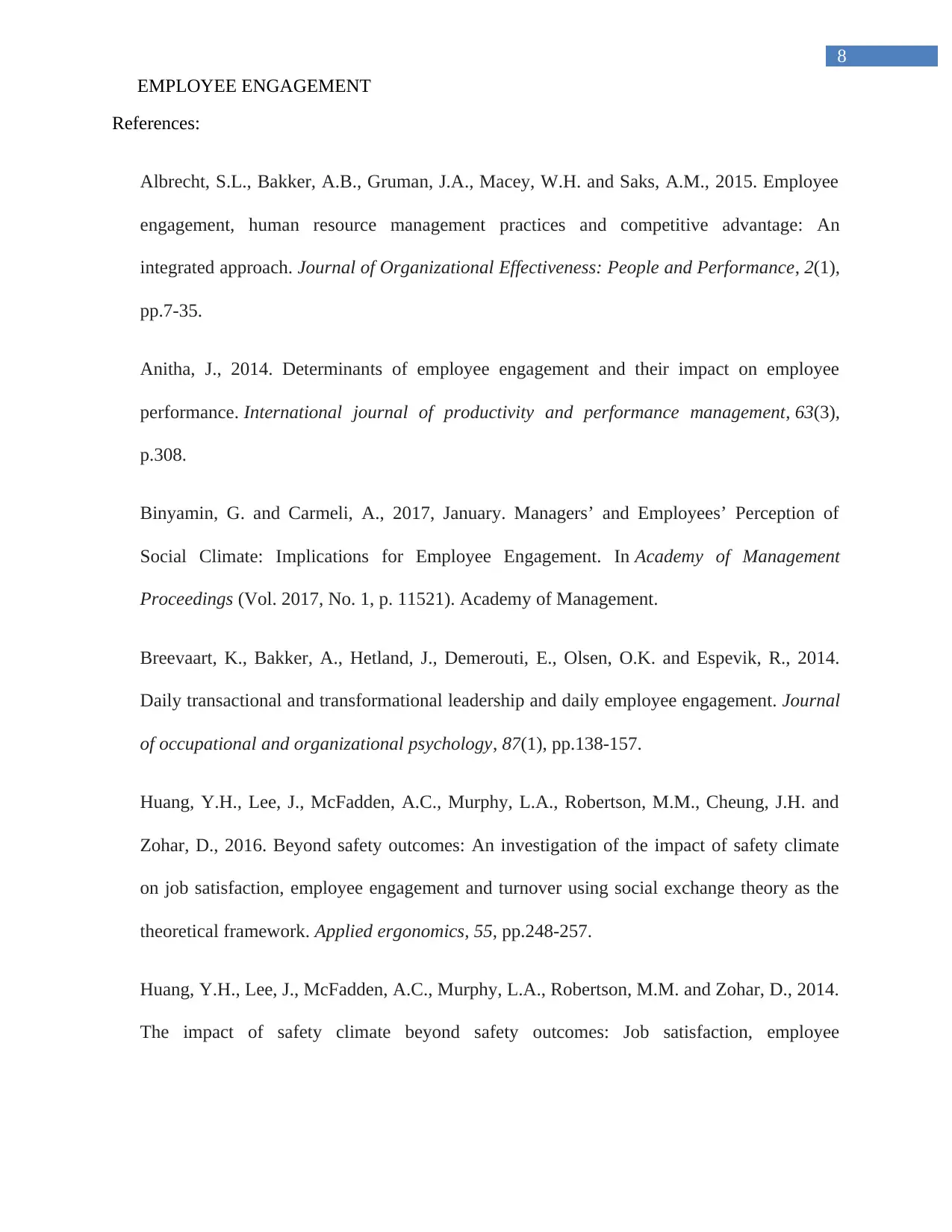
8
EMPLOYEE ENGAGEMENT
References:
Albrecht, S.L., Bakker, A.B., Gruman, J.A., Macey, W.H. and Saks, A.M., 2015. Employee
engagement, human resource management practices and competitive advantage: An
integrated approach. Journal of Organizational Effectiveness: People and Performance, 2(1),
pp.7-35.
Anitha, J., 2014. Determinants of employee engagement and their impact on employee
performance. International journal of productivity and performance management, 63(3),
p.308.
Binyamin, G. and Carmeli, A., 2017, January. Managers’ and Employees’ Perception of
Social Climate: Implications for Employee Engagement. In Academy of Management
Proceedings (Vol. 2017, No. 1, p. 11521). Academy of Management.
Breevaart, K., Bakker, A., Hetland, J., Demerouti, E., Olsen, O.K. and Espevik, R., 2014.
Daily transactional and transformational leadership and daily employee engagement. Journal
of occupational and organizational psychology, 87(1), pp.138-157.
Huang, Y.H., Lee, J., McFadden, A.C., Murphy, L.A., Robertson, M.M., Cheung, J.H. and
Zohar, D., 2016. Beyond safety outcomes: An investigation of the impact of safety climate
on job satisfaction, employee engagement and turnover using social exchange theory as the
theoretical framework. Applied ergonomics, 55, pp.248-257.
Huang, Y.H., Lee, J., McFadden, A.C., Murphy, L.A., Robertson, M.M. and Zohar, D., 2014.
The impact of safety climate beyond safety outcomes: Job satisfaction, employee
EMPLOYEE ENGAGEMENT
References:
Albrecht, S.L., Bakker, A.B., Gruman, J.A., Macey, W.H. and Saks, A.M., 2015. Employee
engagement, human resource management practices and competitive advantage: An
integrated approach. Journal of Organizational Effectiveness: People and Performance, 2(1),
pp.7-35.
Anitha, J., 2014. Determinants of employee engagement and their impact on employee
performance. International journal of productivity and performance management, 63(3),
p.308.
Binyamin, G. and Carmeli, A., 2017, January. Managers’ and Employees’ Perception of
Social Climate: Implications for Employee Engagement. In Academy of Management
Proceedings (Vol. 2017, No. 1, p. 11521). Academy of Management.
Breevaart, K., Bakker, A., Hetland, J., Demerouti, E., Olsen, O.K. and Espevik, R., 2014.
Daily transactional and transformational leadership and daily employee engagement. Journal
of occupational and organizational psychology, 87(1), pp.138-157.
Huang, Y.H., Lee, J., McFadden, A.C., Murphy, L.A., Robertson, M.M., Cheung, J.H. and
Zohar, D., 2016. Beyond safety outcomes: An investigation of the impact of safety climate
on job satisfaction, employee engagement and turnover using social exchange theory as the
theoretical framework. Applied ergonomics, 55, pp.248-257.
Huang, Y.H., Lee, J., McFadden, A.C., Murphy, L.A., Robertson, M.M. and Zohar, D., 2014.
The impact of safety climate beyond safety outcomes: Job satisfaction, employee
⊘ This is a preview!⊘
Do you want full access?
Subscribe today to unlock all pages.

Trusted by 1+ million students worldwide
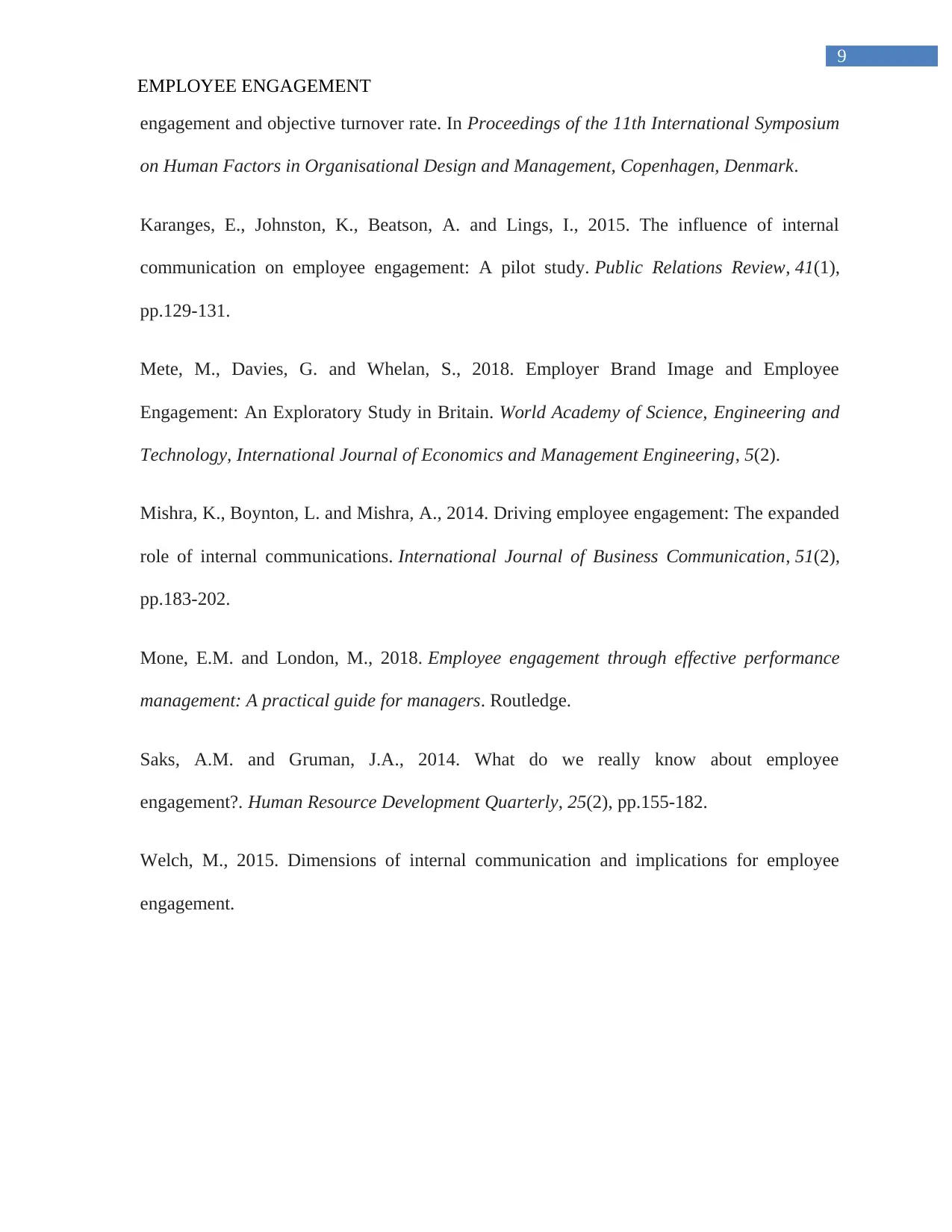
9
EMPLOYEE ENGAGEMENT
engagement and objective turnover rate. In Proceedings of the 11th International Symposium
on Human Factors in Organisational Design and Management, Copenhagen, Denmark.
Karanges, E., Johnston, K., Beatson, A. and Lings, I., 2015. The influence of internal
communication on employee engagement: A pilot study. Public Relations Review, 41(1),
pp.129-131.
Mete, M., Davies, G. and Whelan, S., 2018. Employer Brand Image and Employee
Engagement: An Exploratory Study in Britain. World Academy of Science, Engineering and
Technology, International Journal of Economics and Management Engineering, 5(2).
Mishra, K., Boynton, L. and Mishra, A., 2014. Driving employee engagement: The expanded
role of internal communications. International Journal of Business Communication, 51(2),
pp.183-202.
Mone, E.M. and London, M., 2018. Employee engagement through effective performance
management: A practical guide for managers. Routledge.
Saks, A.M. and Gruman, J.A., 2014. What do we really know about employee
engagement?. Human Resource Development Quarterly, 25(2), pp.155-182.
Welch, M., 2015. Dimensions of internal communication and implications for employee
engagement.
EMPLOYEE ENGAGEMENT
engagement and objective turnover rate. In Proceedings of the 11th International Symposium
on Human Factors in Organisational Design and Management, Copenhagen, Denmark.
Karanges, E., Johnston, K., Beatson, A. and Lings, I., 2015. The influence of internal
communication on employee engagement: A pilot study. Public Relations Review, 41(1),
pp.129-131.
Mete, M., Davies, G. and Whelan, S., 2018. Employer Brand Image and Employee
Engagement: An Exploratory Study in Britain. World Academy of Science, Engineering and
Technology, International Journal of Economics and Management Engineering, 5(2).
Mishra, K., Boynton, L. and Mishra, A., 2014. Driving employee engagement: The expanded
role of internal communications. International Journal of Business Communication, 51(2),
pp.183-202.
Mone, E.M. and London, M., 2018. Employee engagement through effective performance
management: A practical guide for managers. Routledge.
Saks, A.M. and Gruman, J.A., 2014. What do we really know about employee
engagement?. Human Resource Development Quarterly, 25(2), pp.155-182.
Welch, M., 2015. Dimensions of internal communication and implications for employee
engagement.
1 out of 10
Related Documents
Your All-in-One AI-Powered Toolkit for Academic Success.
+13062052269
info@desklib.com
Available 24*7 on WhatsApp / Email
![[object Object]](/_next/static/media/star-bottom.7253800d.svg)
Unlock your academic potential
Copyright © 2020–2025 A2Z Services. All Rights Reserved. Developed and managed by ZUCOL.





